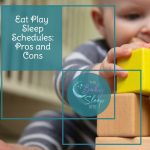
As a seasoned baby sleep consultant with over 15 years of experience, I’ve witnessed firsthand the challenges parents face in establishing healthy sleep habits for their little ones. One of the most effective routines I have seen work over the years is the Eat-Play-Sleep routine. This routine promotes better sleep and ensures your baby gets the nourishment, stimulation, and rest they need for optimal development.
Understanding the Eat-Play-Sleep Cycle
The eat-play-sleep routine revolves around three key activities: feeding, engaging in stimulating playtime, and then settling down for sleep. By following this sequence, you encourage your baby to associate feeding with wakefulness and sleep with relaxation, fostering a natural rhythm that promotes better sleep patterns.
The other benefit of this routine is that you avoid feeding your baby to sleep which can become problematic. When you feed your baby till asleep, they can develop a sleep association with the nipple which can cause frequent night-waking and short naps.
Implementing the Eat-Play-Sleep Routine
1. Feeding Time:
Start the cycle with a feeding session right after your baby wakes up. Whether you breastfeed or bottle-feed, ensure your baby gets enough nourishment to sustain them until the next feeding. Aim for a calm and relaxed environment, minimizing distractions to help your baby focus on eating.
You may also be interested in…
2. Playtime:
After feeding, engage your baby in age-appropriate stimulating activities to encourage physical and cognitive development. This could include tummy time, sensory play, or simply interacting with toys and exploring their surroundings. Keep the play session lively but not overstimulating, as you want to avoid making it difficult for your baby to wind down for sleep later. Note: If your baby is perceptive / alert, they may get overstimulated faster.
You may also be interested in…
3. Wind-Down for Sleep:
As your baby starts showing signs of tiredness, such as starting off into space and yawning, it’s time to transition to sleep. Note that if your baby is fussy and/or rubbing their eyes, you are already too late! Create a soothing bedtime routine that signals your baby that it’s time to relax and prepare for sleep. This could involve gentle rocking, dimming the lights, and singing a lullaby. The goal is to create a calm and consistent sleep environment that cues your baby’s body and brain to rest.
Tips for Success
Although the eat-play-sleep routine sounds simple, babies are not robots and aren’t always predictable. Predictability is actually a temperament trait, meaning your baby is born with it (or not!) Here are tips to be successful with Eat Play Sleep:
- Stay Flexible: While consistency is key, it’s important to remain flexible and adapt the routine to suit your baby’s individual needs. Babies grow and develop at different rates, so be prepared to adjust the timing and duration of each activity as necessary.
- Watch for Cues: Pay close attention to your baby’s cues and signals throughout the day. Recognizing when they’re hungry, alert, or tired will help you anticipate their needs and facilitate a smoother transition between activities.
- Establish Consistent Sleep Associations: Create consistent sleep cues, such as a favorite story or song. Add a blanket or stuffed animal, when baby is a bit older, to signal bedtime. Over time, these associations will help your baby feel secure and comfortable as they drift off to sleep.
- Be Patient: Establishing a new routine takes time and patience. Don’t be discouraged by setbacks or rough nights. Stay consistent and trust that with time, your baby will adjust to the eat-play-sleep cycle.
Final Thoughts About Eat-Play-Sleep
The Eat Play Sleep Routine offers a structured yet flexible approach to baby care, promoting healthy sleep habits while nurturing your baby’s growth and development. By following the simple steps outlined above and staying attuned to your baby’s needs, you can lay the foundation for restful nights and happy days for both you and your little one. However, consider that the routine doesn’t work for every baby. There are pros and cons to the routine, and it’s important to find something that works for your individual baby.








